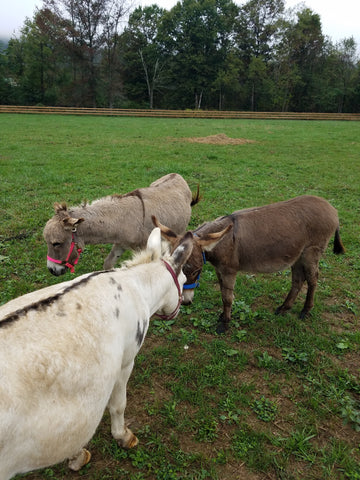The time has come. The quarantine is over. The new donkey is tired of being a single and more than ready to mingle.
This step in the process may seem like the easiest, but a good amount of thought needs to go into where the new addition should pasture. Consider whether there are any dietary or mobility impairments that would impact the location. If their needs are more severe, in either case, it may be wise to create a separate herd for those who require more attention. This will make it easier on the owner, and keep the donkey from getting injured by the more agile and playful animals.
Not all donkeys get along well with others. Domesticated donkeys can be prone to territorial behavior, and this may cause them to be absolute terrors to those they dislike. Finding animals they can create a bond with, or who will tolerate them, is essential.
Take Jingle for example, The Sassy Ass’s first miniature donkey. He is known for grabbing horses by their tail, biting and pulling on their halter, chasing his pasture mates around like a rabid dog, and walking under them whenever he pleases. Bless the heart of every horse who has wintered a season with him as a companion.
While most of the time he is all fun and games, he does have his unpredictable moments. When a blind horse came to the farm, Jingle was switched to his pasture to be a sort of therapy animal. It does not always go well. The tiny brute has bullied his way to the feed bucket a time or two, nipping and grunting to keep the poor old horse at bay. (Visit @the_sassy_ass on Instagram for a visual aid.) Fortunately, many donkeys do not have this same, uh, unique personality, and finding the right location for them is relatively easy.
Once the pasture mates are decided on, the process of introducing the new addition can begin. Depending on level of comfort and experience, it could take anywhere from an hour to several days to integrate a new member. A second person to help with the process can be convenient in the case of a temperamental interaction, but is not a must. For the cautious at heart, let the new donkey live in the same barn as the herd that it is intended to join, or put them in an adjourning pasture. Allow them to take it upon themselves to sniff and possibly groom each other. For those with more experience, start by introducing them with a fence as a barrier, then bring them into the pasture on a lead rope.

Signs to look for that show the donkey is responding negatively are kicking, biting, lunging with their head down and ears pinned, rearing up, and chasing. Do not mistake a donkey’s ears facing back in their resting pose as pinned ears. Other signs off irritability or fear are flared nostrils, increased whites around the eyes, and open mouth with exposed teeth. This may seem stressful, but it is not out of the ordinary.
Keep in mind, every interaction will be different. While minor fighting is not a cause for immediate alarm, it does need to be observed. It may be that the animals are testing each other as they get to know one another. As long as no one is overdoing it, or causing harm, there is no reason to intervene. Allowing them to figure it out themselves is not a bad idea. The herd often has a hierarchy and it is best that it be presented in the beginning to prevent future skirmishes.

However, if the fighting escalates, it will be necessary to break up the conflict. It is best that one does not try to physically intervene in the altercation. Try to create a distraction and encourage them to move away from each other. If it becomes necessary to break up an interaction, do not try and introduce the animals again right away. Give them time apart to settle down and get comfortable.
Often times, the introduction process goes smoothly. Yet, there are cases where the new member simply does not get along with those in a certain pasture. Watch close to see if the donkey interacts agreeably with any of the animals. If they interact well with one animal, but not another, the herd can be split. Be careful not to separate bonded pairs.
Do not be discouraged if everything does not go as planned. It is a donkey after all. They have a reputation for being stubborn for a reason. Choose to bask in the adorable sass that is their personality.

